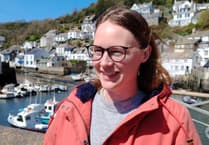Beware! It’s the start of the South West’s tropical rainy season.
I realise that is a crazy statement to make at the height of summer and just as the school holidays are beginning, but experience has taught me that these next few weeks are often when we see some of the worst flooding.
I also realise that this particular “rainy” season feels like it has been continuous for the last twelve months!
However, never underestimate the sheer volume of rain that can suddenly overwhelm us in July and August.
These two months stand out for me when I look back over my broadcasting career and the number of times I was sent out to cover the effects of flash flooding in Devon and Cornwall.
In fact my very first assignment when I started at Spotlight in August 1997 was to go to Ottery St Mary in Devon and report on the clear up after a sudden torrential downpour left homes and businesses underwater.
Little did I know at the time that it was the start of a regular pattern of standing in flood-hit communities in mid summer!
The most memorable of course was the freak storm that wrought havoc and devastation in Boscastle in North Cornwall.
I was recently reminded that this year is the twentieth anniversary of the Boscastle flood; a fact I found hard to comprehend. It is still so clear in my mind that I couldn’t quite believe it happened two decades ago.
That August day in 2004 started out in an unremarkable way with no hint of what was to come.
I went to work as normal and as far as I can recall it was a fairly warm and sunny day in Plymouth with no sign of any rain.
We spent the day preparing for Spotlight, which at this time of the year can be quite an uphill task.
In television newsrooms the month of August is often described as the “silly season”. Almost everyone is on holiday, very little serious news is happening and we end up reporting on lots of trivial stories.
I can’t remember what was in the running order that day, but it never made it on air because of what unfolded in Boscastle in the middle of the afternoon.
As soon as we became aware of a serious situation developing there we dispatched reporters and camera crews, but it was so late in the afternoon that we had no real hope of providing pictures from the scene by 6.30pm.
That’s when the editor took the rare decision to send a cameraman up in a helicopter. It was extremely costly, but the expensive gamble paid off. The pictures were flown back in time for Spotlight.
They arrived in the building in Plymouth after we had gone on air and were played out unedited. In the studio we were seeing the scale of the destruction for the first time just as viewers were seeing it.
I then spent the rest of that week in August in Boscastle reporting on the clear up and wondering how nobody had died.
It was such a freak event that I never expected to report on anything quite like it again in my career.
But in July 2017, in an eerie echo of Boscastle thirteen years’ earlier, it happened all over again.
That day also started with no sign of how it would end. It was a sunny day in Plymouth. I was presenting Spotlight as usual and it was an average day for news.
But as we went on air a producer spoke into my earpiece: “A major incident has been declared in Coverack, we’re just confirming details and we are hoping to get some phone footage from a viewer, be prepared for a change in the running order”.
We ended the programme that night with that now famous footage of Coverack looking like it was in the middle of Niagara Falls. Water was pouring through the village and cascading over the seawall.
I was sent to Coverack the next day to report on the clear up. I met a couple that had been airlifted from their home after it was rapidly engulfed in floodwater.
They described being swept off their feet by the swirling water in their kitchen and being tossed around like a cork.
At the end of that programme I found myself with unexpectedly longer to speak because of a timing error back in Plymouth, so I had to fill the remaining extra time. I recounted the destruction I’d seen including to the once beautiful home and garden of the couple that had been airlifted to safety.
It is one of the few occasions on television that emotion almost got the better of me and I struggled to control the lump in my throat.
So, that is why I am so wary of the weather in July and August, our so-called “summer” months.
And for readers with even longer memories, August was also the month of the fatal flooding in Lynton and Lynmouth in 1952.
It was before my time, but I was presenting Spotlight when my colleague Teresa Driscoll went to Lynton to mark the fiftieth anniversary of the disaster. We showed archive footage and eyewitness accounts that were frighteningly similar to the events that later unfolded in Boscastle and Coverack.
As I write this, the sun is shining and it is a perfect July day. I hope that we have more days like this over the next few weeks, but history has taught me not to be lulled into a false sense of summer.
We’ve had more than our fair share of freak storms; I think we have earned a more peaceful July and August don’t you?
Bye for now.





Comments
This article has no comments yet. Be the first to leave a comment.